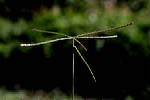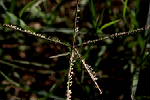





Botany Biology Phenology Ecology Distribution Agricultural importance Cultural control Chemical control
| Description : | Terrestrial, annual or perennial, tufted herb, not rooting at nodes. Roots fibrous, white or brown. Stems rounded, hollow or solid, glabrous. Nodes glabrous. Stipules absent. Leaves simple, alternate distichous, sessile, linear, more than 2 cm long/wide, margin entire, apex acute, base clasping, parallel-veined. Leaf sheath present. Ligule membranous hairy, a conspicuous ring of white short and long hairs. Flowers bisexual, grouped together in a terminal, digitate raceme, sessile, green, petals not visible. Fruit a nut. |